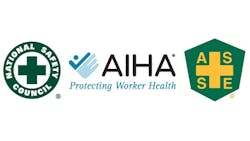Safety Organizations Urge Congressional Support for OSHA, NIOSH
The letter, penned by Janet Froetscher, NSC president and CEO; Allan Fleeger, AIHA president; and Richard Pollock, ASSE president, opened by thanking Harkin for his support of OSHA and NIOSH and applauded the $565.5 million OSHA funding and $292.6 million NIOSH funding as outlined in the Senate Appropriations Committee-approved FY 2013 Labor, Health and Human Services and Education Appropriations bill.
The House FY 13 Labor‐HHS‐Education Appropriations bill, however, funds OSHA at a reduced level of $560 million and contains several “troubling” policy riders, which would:
- Prevent OSHA from promulgating a rule on injury and illness prevention programs
- Prevent OSHA from enforcing parts of an agency standard on grain handling safety in
- silos
- Prevent enforcement of a new OSHA residential construction fall protection directive
- Terminate the Susan Harwood Training Grant Program
“As you confer with the House, we urge you to continue to champion the safety and health of America’s workers by adopting the Senate funding levels and preventing proposed House policy riders that would prevent OSHA and NIOSH from fully fulfilling their life‐saving missions,” the safety stakeholders wrote. “We especially request that you prevent the elimination of funding for NIOSH’s Agriculture, Forestry and Fishing (AgFF) sector program and Education and Research Centers (ERC), both of which play an important role in preventing workplace injuries and deaths.”
Presenting a United Front
“We believe that working together collaboratively is good for the cause of safety,” John Ulczycki, NSC vice president of strategic initiatives, told EHS Today when asked to comment on the nature of the joint letter. “We’re very concerned that some legislators believe we can’t afford to make our workplaces safe and can’t afford to fund regulatory and health and safety agencies to make people safer. When we see issues like this, we feel that speaking collaboratively and in one voice is the right thing.”
Ulczycki added that the membership of NSC, AIHA and ASSE represent the voice of both management and labor, and that not everyone in the business community supports the backlash against appropriate, responsible funding levels for regulatory agencies.
In particular, Ulczycki expressed concern for the rider that would prevent OSHA from promulgating a rule on injury and illness prevention programs.
“A basic, elementary safety management system, or an injury and illness prevention program, is a core element of any company, or it ought to be,” he explained. “If OSHA can’t even regulate the most basic, fundamental standards related to safety, then that’s a real concern. The opposition to OSHA regulation on this issue, coming from some members of the House, is something we don’t understand because we see broad agreement for it in the business community.”
The Value of Safety
In the letter, Froetscher, Fleeger and Pollock stressed that NIOSH provides important programs, including the Agriculture, Forestry and Fishing (AgFF) sector program. AgFF industries, they noted, have the highest fatality rates of any industry, with 580 deaths in 2010, an increase of 6 percent from 2009. The rate of fatal injury in AgFF is 37 percent higher than the next closest industry. in 1990, NIOSH established Centers for Agricultural Disease and Injury Research, Education and Prevention to address those higher rates of injury and illness. The initiative now includes seven regional centers and one national children’s farm safety center to conduct research “leading to evidence-based standards that save lives.”
Furthermore, the letter continued, NIOSH supports education and research in occupational health through academic degree programs and research opportunities, primarily through 17 university‐based Education and Research Centers, including the Heartland Center for Occupational Health and Safety in Iowa City, Iowa. With an aging occupational safety and health workforce, ERCs are essential to training the next generation of professionals. The Centers establish academic, labor and industry research partnerships to achieve these goals. Currently, ERCs are responsible for almost half of post‐baccalaureate graduates entering occupational health and safety fields.
“Please continue to champion the safety and health of American workers by doing everything in your power to maintain stable funding levels for OSHA and NIOSH, prevent harmful policy riders, and ensure the continuation of the AgFF and ERC programs in conference on the FY 2013 Labor‐HHS‐Education Appropriations bill,” the letter concluded.
About the Author

Laura Walter
Laura Walter was formerly senior editor of EHS Today. She is a subject matter expert in EHS compliance and government issues and has covered a variety of topics relating to occupational safety and health. Her writing has earned awards from the American Society of Business Publication Editors (ASBPE), the Trade Association Business Publications International (TABPI) and APEX Awards for Publication Excellence. Her debut novel, Body of Stars (Dutton) was published in 2021.

